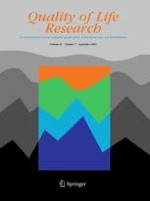01-09-2012
The association between cumulative adversity and mental health: considering dose and primary focus of adversity
Gepubliceerd in: Quality of Life Research | Uitgave 7/2012
Log in om toegang te krijgenAbstract
Purpose
The study addressed the dose–response model in the association of cumulative adversity with mental health.
Method
Data of 1,725 participants aged 50+ were drawn from the Israeli component of the Survey of Health, Ageing, and Retirement in Europe. Measures included an inventory of potentially traumatic events, distress (lifetime depression, depressive symptoms), and well-being (quality of life, optimism/hope).
Results
The maximal effect of cumulative trauma emerged in the contrast between 0–2 and 3+ events, where the higher number of events related to higher distress but also to higher well-being. While self-oriented adversity revealed no, or negative, association with well-being, other-oriented adversity revealed a positive association.
Conclusions
The study suggests an experiential dose of cumulative adversity leading to a co-activation of distress and well-being. The source of this co-activation seems to be other-oriented adversity.
